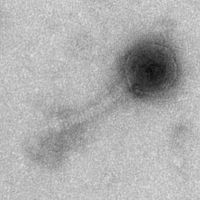
| Detailed Information for Phage Vitas | |
| Discovery Information | |
| Isolation Host | Microbacterium foliorum NRRL B-24224 |
| Found By | Katarzyna Waniolka |
| Year Found | 2018 |
| Location Found | Saint Louis, MO USA |
| Finding Institution | St. Louis Community College |
| Program | Science Education Alliance-Phage Hunters Advancing Genomics and Evolutionary Science |
| From enriched soil sample? | Yes |
| Isolation Temperature | Not entered |
| GPS Coordinates | 38.568051 N, 90.420776 W Map |
| Discovery Notes | Phage Vitas came from the soil sample collected on a rainy day (August 2018). The soil was collected from 2-3 inches deep under the roots of a bush and was mostly dry, brown to almost black, loose with some organic matter. The soil area had some access to the light, but partially shaded. |
| Naming Notes | Phage Vitas was named from Latin word "vitas" that means "lives", because I was hoping that my phage will save the lives of others, and also because my phage (even though producing some halo) appears to be very active ("alive") with the host. |
| Sequencing Information | |
| Sequencing Complete? | Yes |
| Date Sequencing Completed | Nov 30, 2018 |
| Sequencing Facility | Pittsburgh Bacteriophage Institute |
| Shotgun Sequencing Method | Illumina |
| Sequencer Used | Illumina MiSeq |
| Read Type | Single-end reads |
| Read Length | 150 bp |
| Approximate Shotgun Coverage | 692 |
| Genome length (bp) | 39994 |
| Character of genome ends | 3' Sticky Overhang |
| Overhang Length | 10 bases |
| Overhang Sequence | ACTCCCGGCA |
| GC Content | 67.1% |
| Fasta file available? | Yes: Download fasta file |
| Characterization | |
| Cluster | EB |
| Subcluster | -- |
| Cluster Life Cycle | Lytic |
| Other Cluster Members |
Click to ViewAbigail Akino08 Albedo Albright AnnaLie Armstrong Arroyo AvGardian Avocadoman BabyDaisy BabyYoda Bachaco BAjuniper BelmontSKP Bengal Bernstein Brahms BubbaBear Buldak Burritobowl Cashington Celaena ChiliPepper Clayda5 CliffHanger Coltrane CroZenni CupcakePrincess DickRichards Didgeridoo DirtyBubble Dismas Doobus Eden Elva Eula Finalfrontier FlameThrower Franklin22 Gack Icarian IndyLu Jabb Johnathan Jovita Kate33 Katzastrophic Kenzers Kieran Lahqtemish Lilo27 LimaBean Loviatar Lynlen Milomuff MsUbiquitous Nicky22 Olliecat PastaFagioli PhigPhack Phisb PondAmelia QMacho Quenya Rollins Rona SanaSana SansAfet SarBear Sharkboy Shayna Skylord Slay Softsoap Solea Squircle Stoor Stromboli SunnyD Swervy Teagster TukTuk Vitas WalkingDead |
| Annotating Institution | St. Louis Community College |
| Annotation Status | In GenBank |
| Plaque Notes | Vitas phage produces halo areas with double rings that are different in the turbidity. The phages tend to be very active with its host and in less concentrated numbers, some turbidity was seen. No cell formations were noticed in the plaques formed and the plates were consistent in the morphology. The plaques produced varied between 1mm to 3 mm and they were clear in the center, then turbid around, and if they grew larger they had one more ring around them. |
| Number of Genes | 68 |
| Number of tRNAs | 3 |
| Number of tmRNAs | 0 |
| Has been Phamerated? | Yes |
| Gene List |
Click to ViewVitas_1 Vitas_2 Vitas_3 Vitas_4 Vitas_5 Vitas_6 Vitas_7 Vitas_8 Vitas_9 Vitas_10 Vitas_11 Vitas_12 Vitas_13 Vitas_14 Vitas_15 Vitas_16 Vitas_17 Vitas_18 Vitas_19 Vitas_20 Vitas_21 Vitas_22 Vitas_23 Vitas_24 Vitas_25 Vitas_26 Vitas_27 Vitas_28 Vitas_29 Vitas_30 Vitas_31 Vitas_32 Vitas_33 Vitas_34 Vitas_35 Vitas_36 Vitas_37 Vitas_38 Vitas_39 Vitas_40 Vitas_41 Vitas_42 Vitas_43 Vitas_44 Vitas_45 Vitas_46 Vitas_47 Vitas_48 Vitas_49 Vitas_50 Vitas_51 Vitas_52 Vitas_53 Vitas_54 Vitas_55 Vitas_56 Vitas_57 Vitas_58 Vitas_59 Vitas_60 Vitas_61 Vitas_62 Vitas_63 Vitas_64 Vitas_65 Vitas_66 Vitas_67 Vitas_68 — tRNA Vitas_69 — tRNA Vitas_70 — tRNA Vitas_71 |
| Submitted Annotation in DNA Master Format | Download |
| Submitted Minimal DNA Master File | Download |
| Author List | Download |
| Annotation Cover Sheet | Download |
| Publication Info | |
| Uploaded to GenBank? | Yes |
| GenBank Accession | MN183281 |
| Refseq Number | None yet |
| Archiving Info | |
| Archiving status | Archived |
| Pitt Freezer Box# | 76 |
| Pitt Freezer Box Grid# | D5 |
| Available Files | |
| GenBank File for Phamerator | Download |